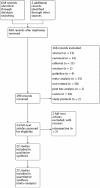What is impact of nonsteroidal anti-inflammatory drugs in the prevention of post-endoscopic retrograde cholangiopancreatography pancreatitis: a meta-analysis of randomized controlled trials
- PMID: 29973142
- PMCID: PMC6032784
- DOI: 10.1186/s12876-018-0837-4
What is impact of nonsteroidal anti-inflammatory drugs in the prevention of post-endoscopic retrograde cholangiopancreatography pancreatitis: a meta-analysis of randomized controlled trials
Abstract
Background: Recently, although studies have investigated the role of NSAIDs in the prevention of post-endoscopic retrograde cholangiopancreatography pancreatitis (PEP), selection of the ideal drug, the time and route of its administration for the appropriate population remain controversial.
Methods: A systematic search was done in sources including PubMed, Embase, Web of Science, the Cochrane Library Central, and ClinicalTrials.gov from from August 1, 1990 to August 1, 2017. Randomized controlled trials comparing the prophylactic use of NSAIDs versus a placebo were included. Statistical analysis was performed using the RevMan 5.3 software to assess the outcomes.
Results: A total of 21 randomized controlled trials were included in the meta-analysis. Our study showed that NSAIDs significantly reduced the incidence of PEP (RR, 0.61, 95%CI,0.52-0.72; p < 0.00001). The analysis showed that indomethacin administration post-ERCP (RR, 0.47; 95% CI, 0.31-0.70; p = 0.0002) appeared to be more effective in preventing PEP than indomethacin administration pre-ERCP (RR, 0.59; 95% CI, 0.45-0.79; P = 0.0003), but there was no significant difference between the high-risk and average-risk population(p = 0.13). In the diclofenac group, it was noted that administration of diclofenac pre-ERCP (RR, 0.32; 95% CI, 0.16-0.63; p = 0.001) was more effective than that in post-ERCP (RR, 0.65; 95% CI, 0.27-1.599; p = 0.35). The relative risk of PEP was 0.63 (95% CI, 0.27-1.50; p = 0.30) in high-risk patients and 0.41 (95% CI, 0.17-0.98; p = 0.02) in average-risk patients. With regard to the route of administration, PEP decreased significantly only in patients receiving the drug rectally (RR, 0.53; 95% CI, 0.44-0.63; p < 0.00001), but not for those who received intramuscularly (RR, 0.74; 95% CI, 0.47-1.17; p = 0.20), intravenously (RR, 0.97; 95% CI, 0.51-1.83; p = 0.93), and orally (RR = 0.88; 95% CI, 0.55-0.1.43; p = 0.62).
Conclusions: Rectal administration of NSAIDs (both indomethacin and diclofenac) was effective in preventing PEP in unselected patients. A single dose of indomethacin after ERCP might be effective in preventing PEP in both high-risk and average-risk patients. However, diclofenac administered rectally before ERCP might be protective against PEP in high-risk patients compared to a placebo. However, more high quality head-to-head RCTs are required.
Keywords: Diclofenac; ERCP; Indomethacin; Meta-analysis; NSAIDs; Pancreatitis.
Conflict of interest statement
Ethics approval and consent to participate
Not applicable.
Consent for publication
Not applicable.
Competing interests
The authors declare that they have no competing interests.
Publisher’s Note
Springer Nature remains neutral with regard to jurisdictional claims in published maps and institutional affiliations.
Figures













Similar articles
-
Rectal nonsteroidal anti-inflammatory drugs administration is effective for the prevention of post-ERCP pancreatitis: An updated meta-analysis of randomized controlled trials.Pancreatology. 2017 Sep-Oct;17(5):681-688. doi: 10.1016/j.pan.2017.07.008. Epub 2017 Jul 17. Pancreatology. 2017. PMID: 28734720
-
Pre-endoscopic retrograde cholangiopancreatography (ERCP) administration of rectal indomethacin in unselected patients to reduce post-ERCP pancreatitis: A systematic review and meta-analysis.Indian J Gastroenterol. 2018 Mar;37(2):120-126. doi: 10.1007/s12664-018-0841-1. Epub 2018 Apr 5. Indian J Gastroenterol. 2018. PMID: 29619673
-
A meta-analysis on the role of rectal diclofenac and indomethacin in the prevention of post-endoscopic retrograde cholangiopancreatography pancreatitis.Pancreas. 2014 Mar;43(2):190-7. doi: 10.1097/MPA.0000000000000090. Pancreas. 2014. PMID: 24518496 Review.
-
Rectal NSAIDs in the prevention of post-endoscopic retrograde cholangiopancreatography pancreatitis in unselected patients: Systematic review and meta-analysis.Dig Endosc. 2017 May;29(3):281-290. doi: 10.1111/den.12816. Epub 2017 Mar 9. Dig Endosc. 2017. PMID: 28112441
-
Prophylactic rectal indomethacin may be ineffective for preventing post-endoscopic retrograde cholangiopancreatography pancreatitis in general patients: A meta-analysis.Dig Endosc. 2017 May;29(3):272-280. doi: 10.1111/den.12779. Epub 2017 Jan 3. Dig Endosc. 2017. PMID: 27914176 Review.
Cited by
-
Clinical outcomes and resource utilization analysis in patients with rheumatoid arthritis undergoing endoscopic retrograde cholangiopancreatography.JGH Open. 2021 Feb 19;5(3):396-400. doi: 10.1002/jgh3.12510. eCollection 2021 Mar. JGH Open. 2021. PMID: 33732888 Free PMC article.
-
Endoscopic retrograde cholangiopancreatography, lights and shadows: Handle with care.World J Gastrointest Endosc. 2019 Mar 16;11(3):219-230. doi: 10.4253/wjge.v11.i3.219. World J Gastrointest Endosc. 2019. PMID: 30918587 Free PMC article. Review.
-
Rectal nonsteroidal anti-inflammatory drugs and pancreatic stents in preventing post-endoscopic retrograde cholangiopancreatography pancreatitis in high-risk patients: A network meta-analysis.Medicine (Baltimore). 2020 Oct 16;99(42):e22672. doi: 10.1097/MD.0000000000022672. Medicine (Baltimore). 2020. PMID: 33080710 Free PMC article.
-
Laparoscopic Transcystic Common Bile Duct Exploration: 8-Year Experience at a Single Institution.J Gastrointest Surg. 2023 Mar;27(3):555-564. doi: 10.1007/s11605-023-05594-z. Epub 2023 Jan 18. J Gastrointest Surg. 2023. PMID: 36652180
-
Laparoscopic common bile duct exploration plus cholecystectomy versus endoscopic retrograde cholangiopancreatography plus laparoscopic cholecystectomy for cholecystocholedocholithiasis: a meta-analysis.Surg Endosc. 2019 Oct;33(10):3275-3286. doi: 10.1007/s00464-018-06613-w. Epub 2018 Dec 3. Surg Endosc. 2019. PMID: 30511313 Review.
References
Publication types
MeSH terms
Substances
Grants and funding
LinkOut - more resources
Full Text Sources
Other Literature Sources
Medical
Miscellaneous

